Pool products retailer Leslie’s (NASDAQ:LESL) missed analysts' expectations in Q1 CY2024, with revenue down 11.4% year on year to $188.7 million. On the other hand, the company's outlook for the full year was close to analysts' estimates with revenue guided to $1.44 billion at the midpoint. It made a non-GAAP loss of $0.17 per share, down from its loss of $0.14 per share in the same quarter last year.
Leslie's (LESL) Q1 CY2024 Highlights:
- Revenue: $188.7 million vs analyst estimates of $200.9 million (6.1% miss)
- Adjusted EBITDA: ($24.4) million loss vs analyst estimates of ($16.8) million loss (miss)
- EPS (non-GAAP): -$0.17 vs analyst estimates of -$0.18
- The company reconfirmed its revenue guidance for the full year of $1.44 billion at the midpoint (adjusted EBITDA and EPS also reconfirmed)
- Gross Margin (GAAP): 28.8%, down from 33.4% in the same quarter last year
- Free Cash Flow was -$56.48 million compared to -$70.71 million in the same quarter last year
- Same-Store Sales were down 12.1% year on year
- Store Locations: 1,000 at quarter end, increasing by 3 over the last 12 months
- Market Capitalization: $906 million
Named after founder Philip Leslie, who established the company in 1963, Leslie’s (NASDAQ:LESL) is a retailer that sells pool and spa supplies, equipment, and maintenance services.
The core customer is therefore a homeowner or commercial property manager who must maintain pools and hot tubs. This customer can count on Leslie’s for products such as pool chemicals, cleaning tools, and accessories such as lights, ladders, and covers. In addition to products, Leslie’s offers professional services such as equipment installation and water testing.
Overall, pools take consistent care to properly maintain, and overlooking or greatly delaying maintenance can lead to an unusable pool (green water, ew!) or much more expensive problems down the line. A number of products sold can therefore border on non-discretionary for a homeowner with a pool. Leslie’s is a one-stop shop for these maintenance and minor repair needs.
Leslie's stores typically range in size from 5,000 to 10,000 square feet. They are positioned in suburban areas with high household incomes and high residential density to increase the odds of nearby pools. In addition to the physical store footprint, Leslie’s has an e-commerce platform where customers can buy products for home delivery or store pickup as well as schedule service appointments.
Specialty Retail
Some retailers try to sell everything under the sun, while others—appropriately called Specialty Retailers—focus on selling a narrow category and aiming to be exceptional at it. Whether it’s eyeglasses, sporting goods, or beauty and cosmetics, these stores win with depth of product in their category as well as in-store expertise and guidance for shoppers who need it. E-commerce competition exists and waning retail foot traffic impacts these retailers, but the magnitude of the headwinds depends on what they sell and what extra value they provide in their stores.
Competitors that sell pool and spa supplies include Pool Corporation (NASDAQ:POOL) and Hayward Holdings (NYSE:HAYW), although these companies sell more to professionals than DIY homeowners.Sales Growth
Leslie's is a small retailer, which sometimes brings disadvantages compared to larger competitors that benefit from economies of scale.
As you can see below, the company's annualized revenue growth rate of 9.4% over the last five years was mediocre as it opened new stores and expanded its reach.
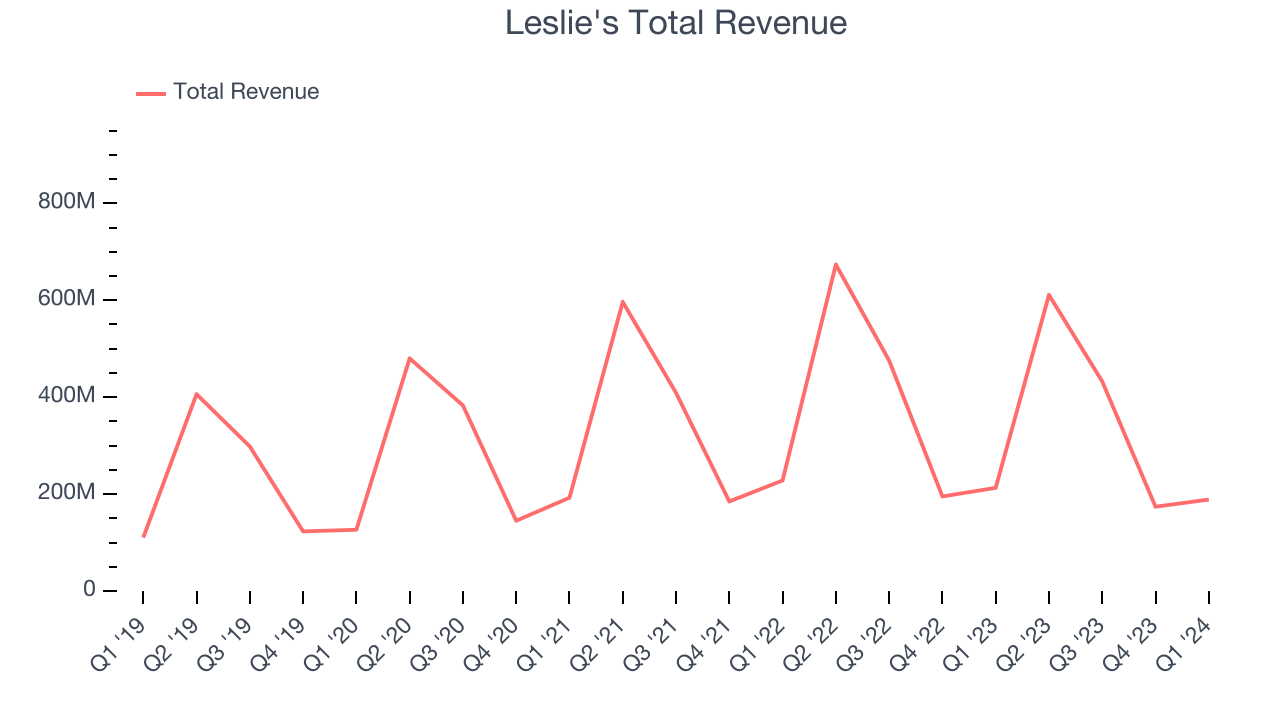
This quarter, Leslie's missed Wall Street's estimates and reported a rather uninspiring 11.4% year-on-year revenue decline, generating $188.7 million in revenue. Looking ahead, Wall Street expects sales to grow 3.5% over the next 12 months, an acceleration from this quarter.
Same-Store Sales
Leslie's demand has been shrinking over the last eight quarters, and on average, its same-store sales have declined by 5.8% year on year. This performance is quite concerning and the company should reconsider its strategy before investing its precious capital into new store buildouts.
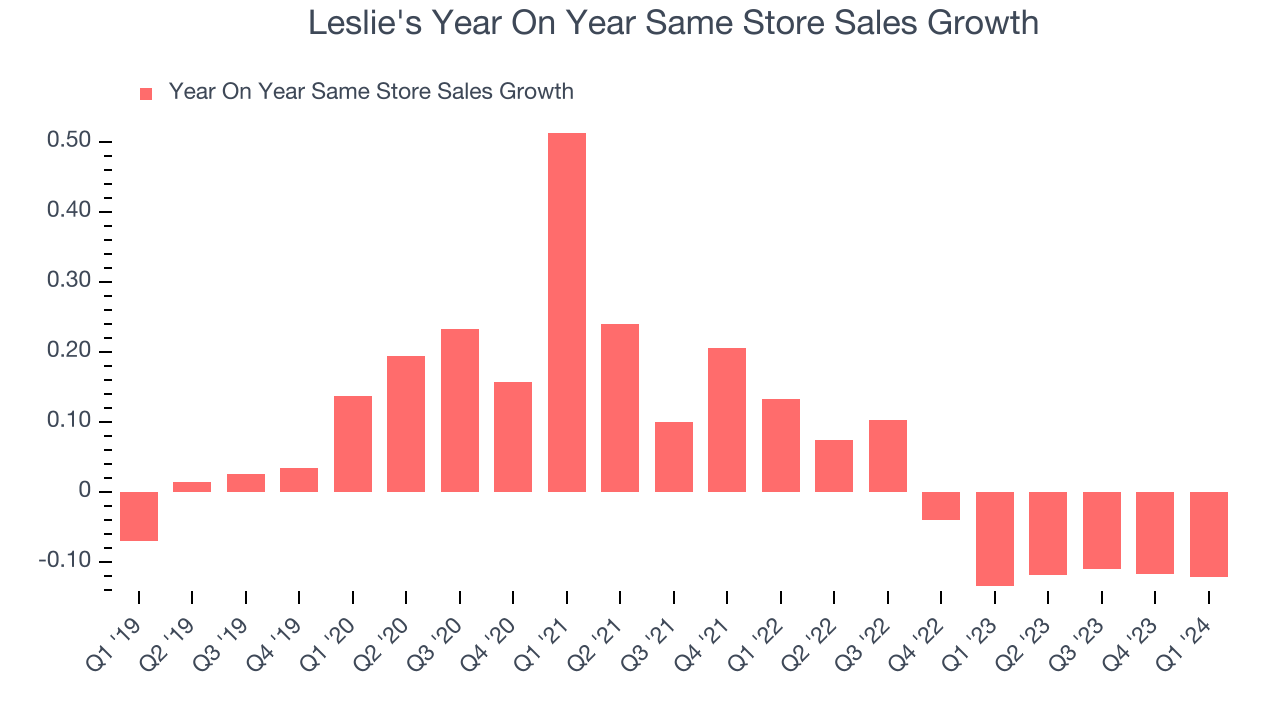
In the latest quarter, Leslie's same-store sales fell 12.1% year on year. This decrease was a further deceleration from the 13.5% year-on-year decline it posted 12 months ago. We hope the business can get back on track.
Number of Stores
When a retailer like Leslie's is opening new stores, it usually means it's investing for growth because demand is greater than supply. At the end of this quarter, Leslie's operated 1,000 total retail locations, in line with its store count 12 months ago.
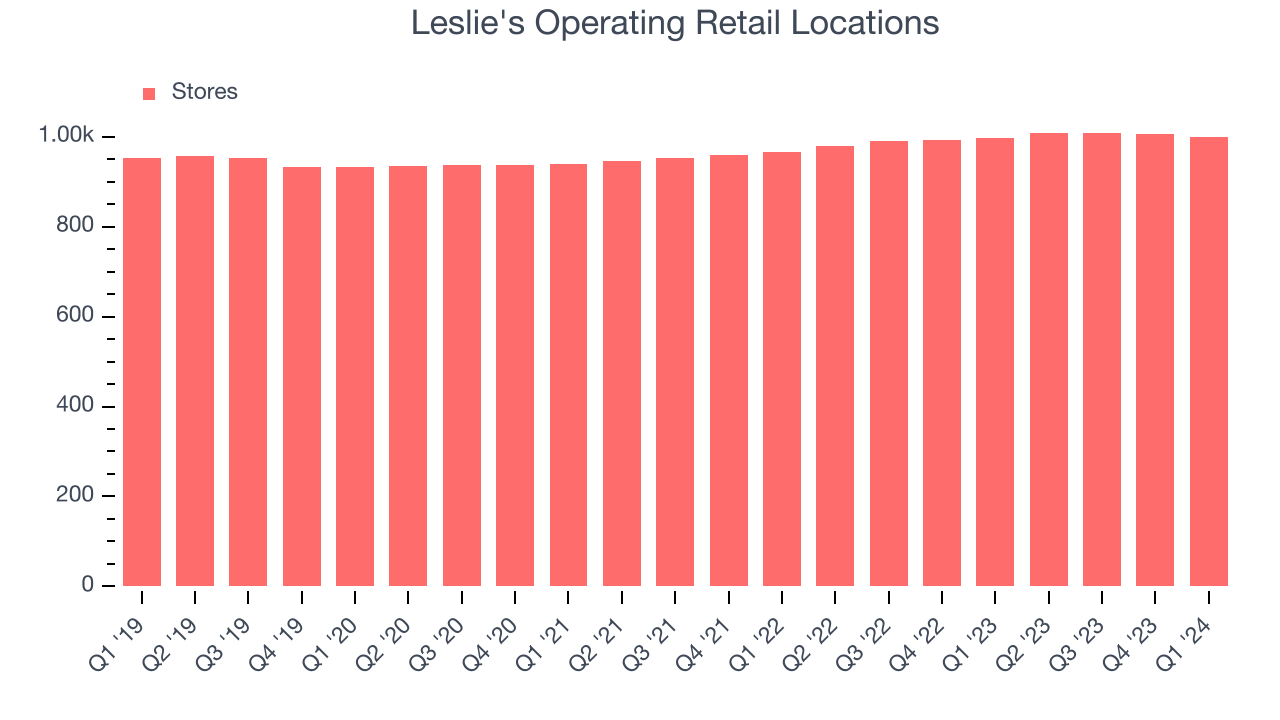
Over the last two years, the company has generally opened new stores and averaged 2.6% annual growth in its physical footprint, which is decent and on par with the broader sector. With an expanding store base and demand, revenue growth can come from multiple vectors: sales from new stores, sales from e-commerce, or increased foot traffic and higher sales per customer at existing stores.
Gross Margin & Pricing Power
Gross profit margins tell us how much money a retailer gets to keep after paying for the goods it sells.
Leslie's has good unit economics for a retailer, giving it the opportunity to invest in areas such as marketing and talent to stay competitive. As you can see below, it's averaged a healthy 39.6% gross margin over the last two years. This means the company makes $0.40 for every $1 in revenue before accounting for its operating expenses.
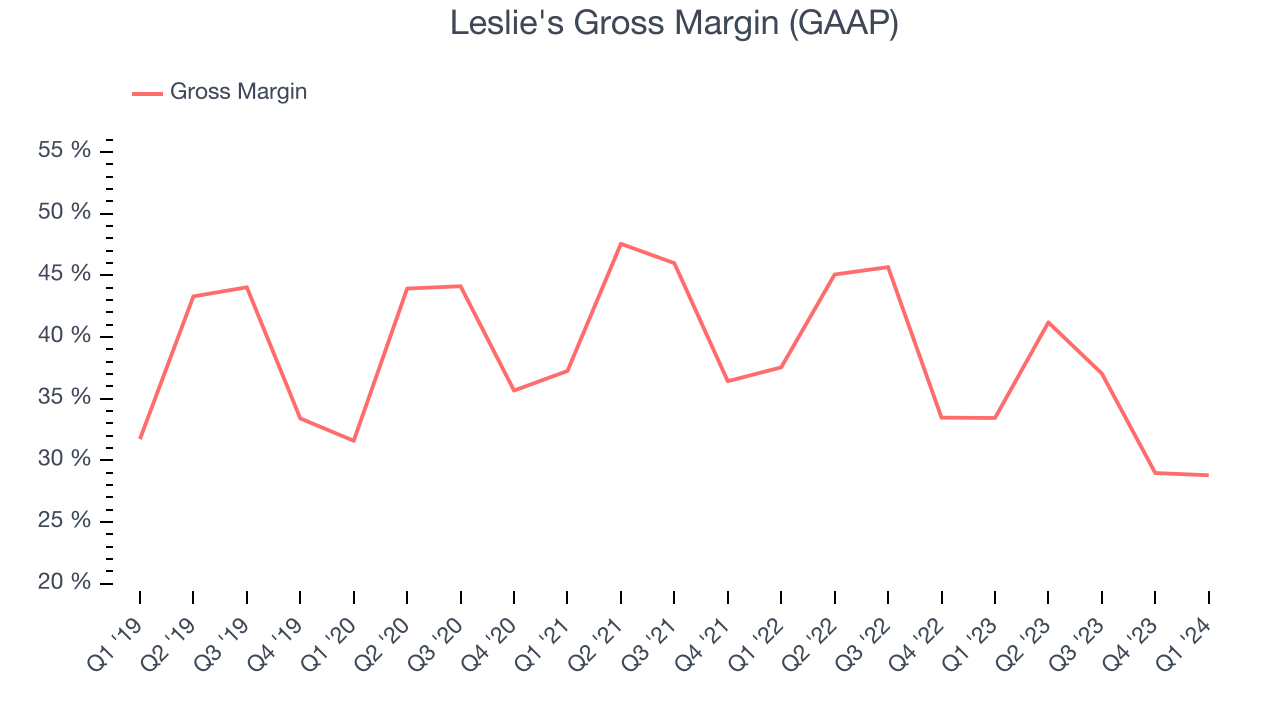
Leslie's gross profit margin came in at 28.8% this quarter, marking a 4.6 percentage point decrease from 33.4% in the same quarter last year. Although the company could've performed better, we care more about its long-term trends rather than just one quarter. Additionally, a retailer's gross margin can often change due to factors outside its control, such as product discounting and dynamic input costs (think distribution and freight expenses to move goods). We'll keep a close eye on this.
Operating Margin
Operating margin is an important measure of profitability for retailers as it accounts for all expenses keeping the lights on, including wages, rent, advertising, and other administrative costs.
This quarter, Leslie's generated an operating profit margin of negative 16.2%, down 4.3 percentage points year on year. This reduction was driven by weaker pricing power, as indicated by the company's larger drop in gross margin.
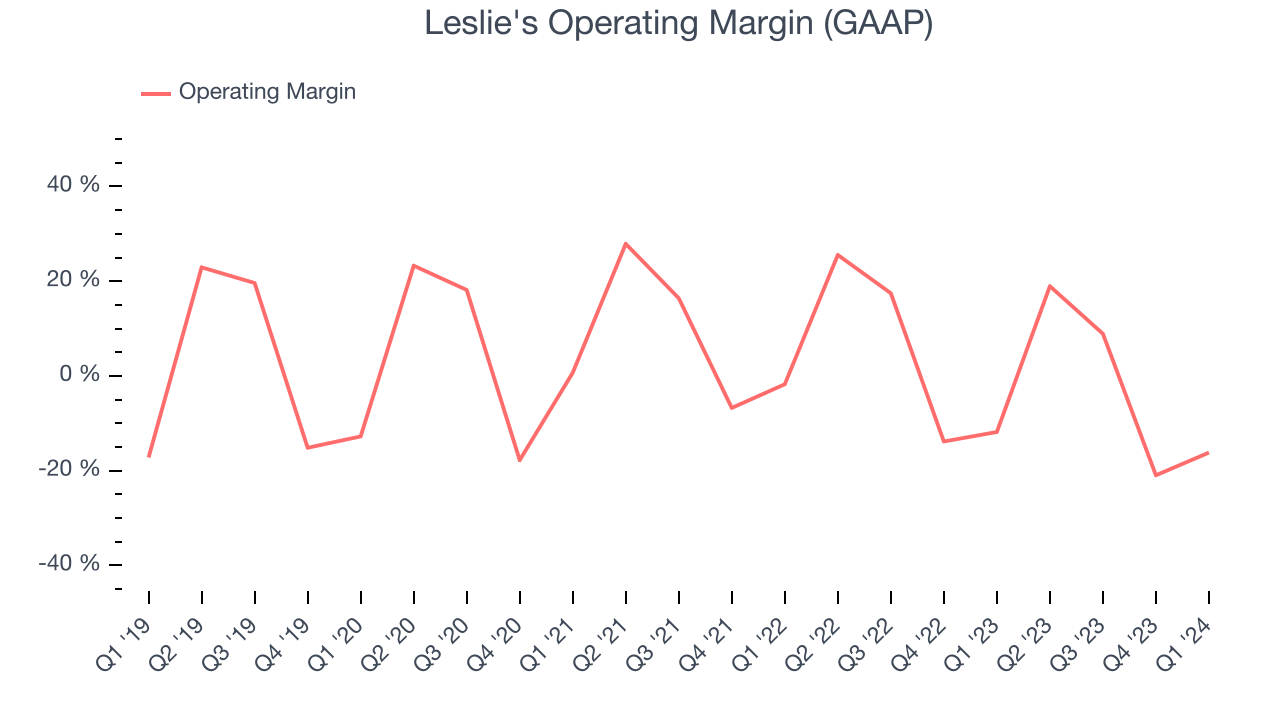 Zooming out, Leslie's has done a decent job managing its expenses over the last eight quarters. It's produced an average operating margin of 9.8%, higher than the broader consumer retail sector. However, Leslie's margin has declined by 6.8 percentage points year on year (on average). Although this isn't the end of the world, some investors were likely hoping for better results.
Zooming out, Leslie's has done a decent job managing its expenses over the last eight quarters. It's produced an average operating margin of 9.8%, higher than the broader consumer retail sector. However, Leslie's margin has declined by 6.8 percentage points year on year (on average). Although this isn't the end of the world, some investors were likely hoping for better results. EPS
These days, some companies issue new shares like there's no tomorrow. That's why we like to track earnings per share (EPS) because it accounts for shareholder dilution and share buybacks.
In Q1, Leslie's reported EPS at negative $0.17, down from negative $0.14 in the same quarter a year ago. This print beat Wall Street's estimates by 3.3%.
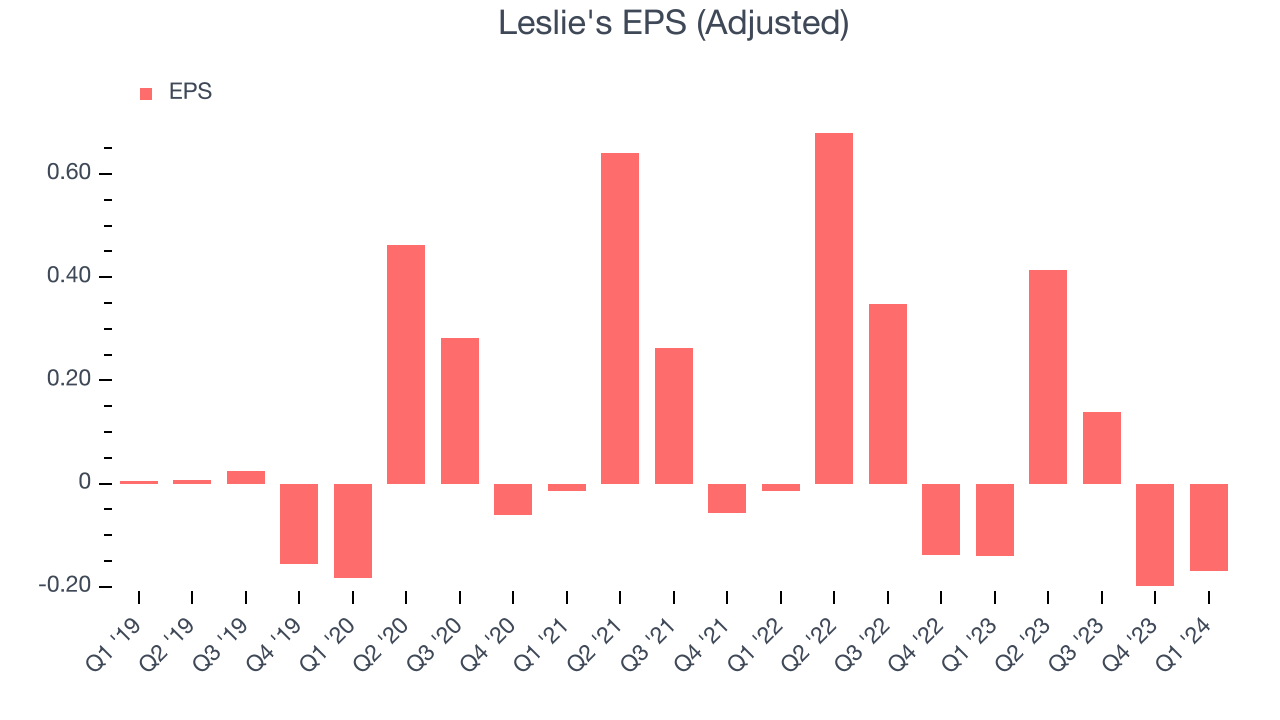
On the bright side, Wall Street expects the company's earnings to grow over the next 12 months, with analysts projecting an average 74.1% year-on-year increase in EPS.
Cash Is King
Although earnings are undoubtedly valuable for assessing company performance, we believe cash is king because you can't use accounting profits to pay the bills.
Leslie's burned through $56.48 million of cash in Q1, representing a negative 29.9% free cash flow margin. The company increased its cash burn by 20.1% year on year.
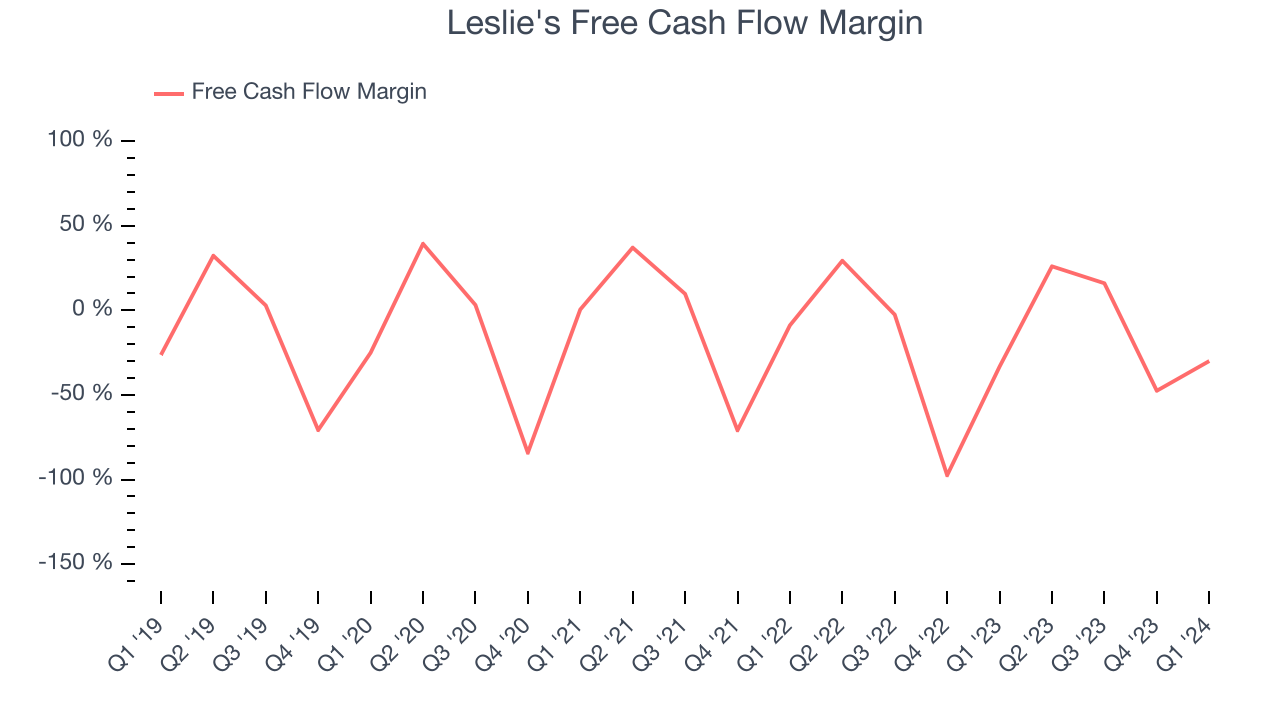
Over the last eight quarters, Leslie's has shown mediocre cash profitability, putting it in a pinch as it gives the company limited opportunities to reinvest, pay down debt, or return capital to shareholders. Its free cash flow margin has averaged 0.5%, subpar for a consumer retail business. However, its margin has averaged year-on-year increases of 11.2 percentage points. Shareholders should be excited as this will certainly help Leslie's reach the next level of profitability.
Return on Invested Capital (ROIC)
EPS and free cash flow tell us whether a company was profitable while growing revenue. But was it capital-efficient? Enter ROIC, a metric showing how much operating profit a company generates relative to how much money the business raised (debt and equity).
Although Leslie's hasn't been the highest-quality company lately, it historically did a wonderful job investing in profitable business initiatives. Its five-year average ROIC was 26.3%, splendid for a retail business.
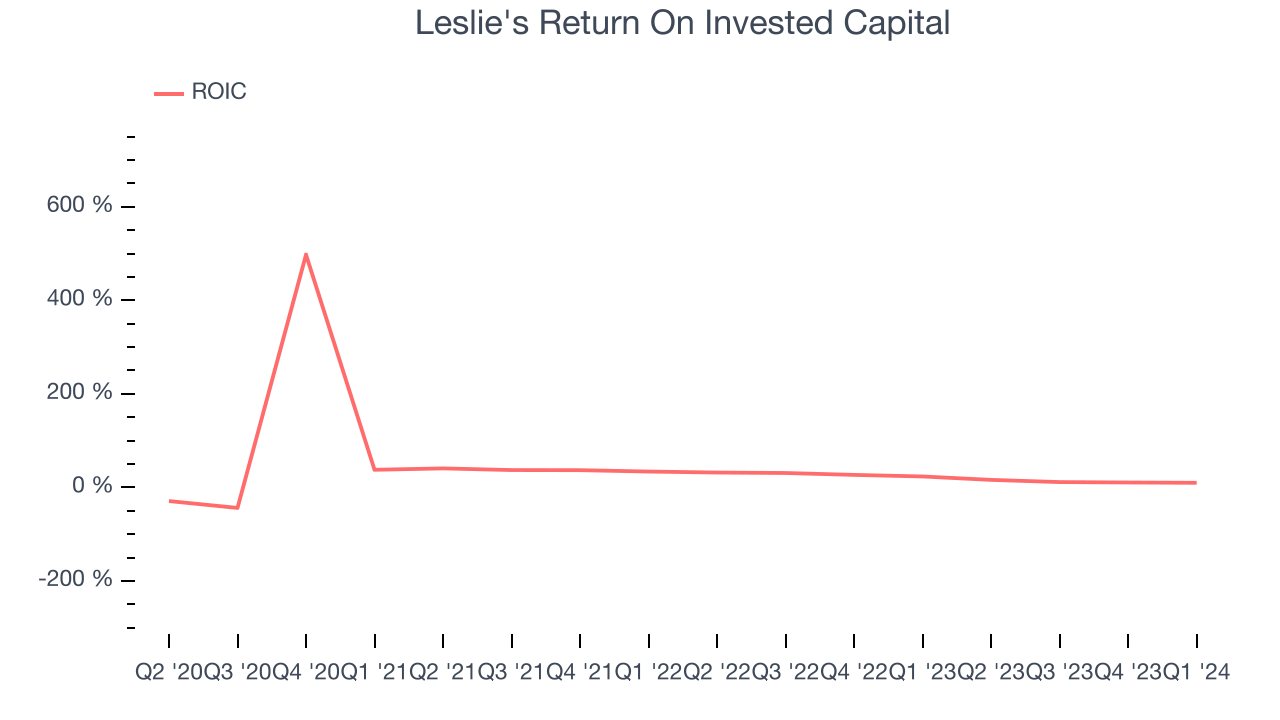
The trend in its ROIC, however, is often what surprises the market and drives the stock price. Unfortunately, Leslie's ROIC significantly decreased over the last few years. We like what management has done historically but are concerned its ROIC is declining, perhaps a symptom of waning business opportunities to invest profitably.
Balance Sheet Risk
Debt is a tool that can boost company returns but presents risks if used irresponsibly.
Leslie's $1.13 billion of debt exceeds the $8.44 million of cash on its balance sheet. Furthermore, its 8x net-debt-to-EBITDA ratio (based on its EBITDA of $144.8 million over the last 12 months) shows the company is overleveraged.
At this level of debt, incremental borrowing becomes increasingly expensive and credit agencies could downgrade the company’s rating if profitability falls. Leslie's could also be backed into a corner if the market turns unexpectedly – a situation we seek to avoid as investors in high-quality companies.
We hope Leslie's can improve its balance sheet and remain cautious until it increases its profitability or reduces its debt.
Key Takeaways from Leslie's Q1 Results
We enjoyed seeing Leslie's beat analysts' full-year earnings guidance expectations. We were also happy its EPS narrowly outperformed Wall Street's estimates. On the other hand, its revenue and adjusted EBITDA unfortunately missed analysts' expectations. Overall, the results could have been better. The company is down 1.5% on the results and currently trades at $4.61 per share.
Is Now The Time?
Leslie's may have had a tough quarter, but investors should also consider its valuation and business qualities when assessing the investment opportunity.
We cheer for all companies serving consumers, but in the case of Leslie's, we'll be cheering from the sidelines. Its revenue growth has been mediocre over the last five years, and analysts expect growth to deteriorate from here. And while its projected EPS for the next year implies the company's fundamentals will improve, the downside is its declining EPS over the last five years makes it hard to trust. On top of that, its shrinking same-store sales suggests it'll need to change its strategy to succeed.
Leslie's price-to-earnings ratio based on the next 12 months is 14.7x. While there are some things to like about Leslie's and its valuation is reasonable, we think there are better opportunities elsewhere in the market right now.
Wall Street analysts covering the company had a one-year price target of $6.56 per share right before these results (compared to the current share price of $4.61).
To get the best start with StockStory, check out our most recent stock picks, and then sign up to our earnings alerts by adding companies to your watchlist here. We typically have the quarterly earnings results analyzed within seconds of the data being released, and especially for companies reporting pre-market, this often gives investors the chance to react to the results before the market has fully absorbed the information.
